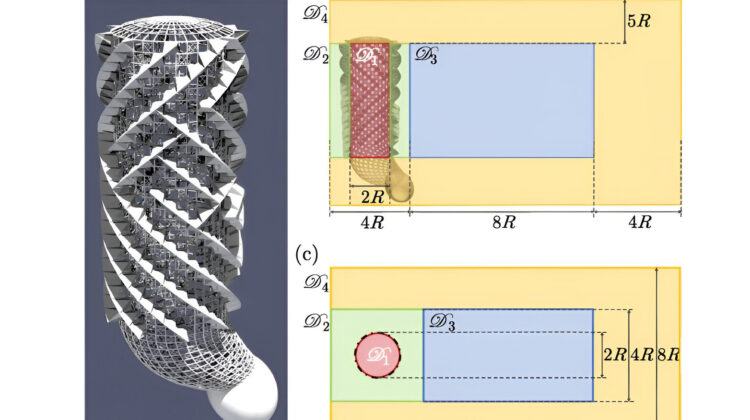
New research co-led by New York University’s Tandon School of Engineering into a deep sea sponge’s ‘zero-energy’ flow control could inspire new energy efficient designs.
The Venus flower basket sponge, which has a delicate, glass-like lattice outer skeleton, has long intrigued researchers seeking to explain how this fragile-seeming creature’s body can withstand the harsh conditions of the deep sea in which it lives. The new research has revealed yet another engineering feat of this ancient animal’s structure: its ability to filter feed using only the faint ambient currents of the ocean depths, without the need for pumping.
This discovery of natural ‘zero energy’ flow control by an international research team co-led by University of Rome Tor Vergata and NYU Tandon School of Engineering could help engineers design more efficient chemical reactors, air purification systems, heat exchangers, hydraulic systems and aerodynamic surfaces.
Using extremely high-resolution computer simulations, the team discovered how the sponge’s skeletal structure diverts very slow deep sea currents so that they flow upwards into its central body cavity, enabling it to feed on plankton and marine detritus that it filters from the water.
The sponge achieves this thanks to its spiral, ridged outer surface, which functions like a spiral staircase. This allows it to passively draw water upwards through its porous, lattice-like frame, all without the energy demands of pumping.
‘Our research settles a debate that has emerged in recent years: the Venus flower basket sponge may be able to draw in nutrients passively, without any active pumping mechanism,’ said Maurizio Porfiri, an NYU Tandon Institute professor. ‘It’s an incredible adaptation, allowing this filter feeder to thrive in currents normally unsuitable for suspension feeding.’
At higher flow speeds, the lattice structure helps reduce drag on the organism. But it’s in the near-stillness of the deep ocean floor that this natural ventilation system is most remarkable, and demonstrates just how well the sponge has adapted to its harsh environment. The study found that the sponge’s ability to passively draw in food works only at the very slow current speeds – just centimetres per second – of its habitat.
‘From an engineering perspective, the skeletal system of the sponge shows remarkable adaptations to its environment, not only from the structural point of view, but also for what concerns its fluid dynamic performance,’ said Giacomo Falcucci of Tor Vergata University of Rome and Harvard University. ‘The sponge has arrived at an elegant solution for maximising nutrient supply while operating entirely through passive mechanisms.’
The researchers used the powerful Leonardo supercomputer at CINECA, a supercomputing centre in Italy, to create a highly realistic 3D replica of the sponge, containing around 100 billion individual points that recreate the sponge’s complex helical ridge structure. This ‘digital twin’ allows experimentation that’s impossible on live sponges, which can’t survive outside their deep-sea environment.
The team performed highly detailed simulations of water flow around and inside the computer model of the sponge’s skeleton. With Leonardo’s enormous computing power, amounting to quadrillions of calculations per second, they could simulate a wide range of water flow speeds and conditions.
The researchers say that the biomimetic engineering insights they uncovered could help guide the design of more efficient reactors by optimising flow patterns inside while minimising drag outside. Similar ridged, porous surfaces could enhance air filtration and ventilation systems in skyscrapers and other structures. The asymmetric, helical ridges may even inspire low-drag hulls or fuselages that stay streamlined while promoting interior air flows.
The research has been published in Physical Review Letters.


